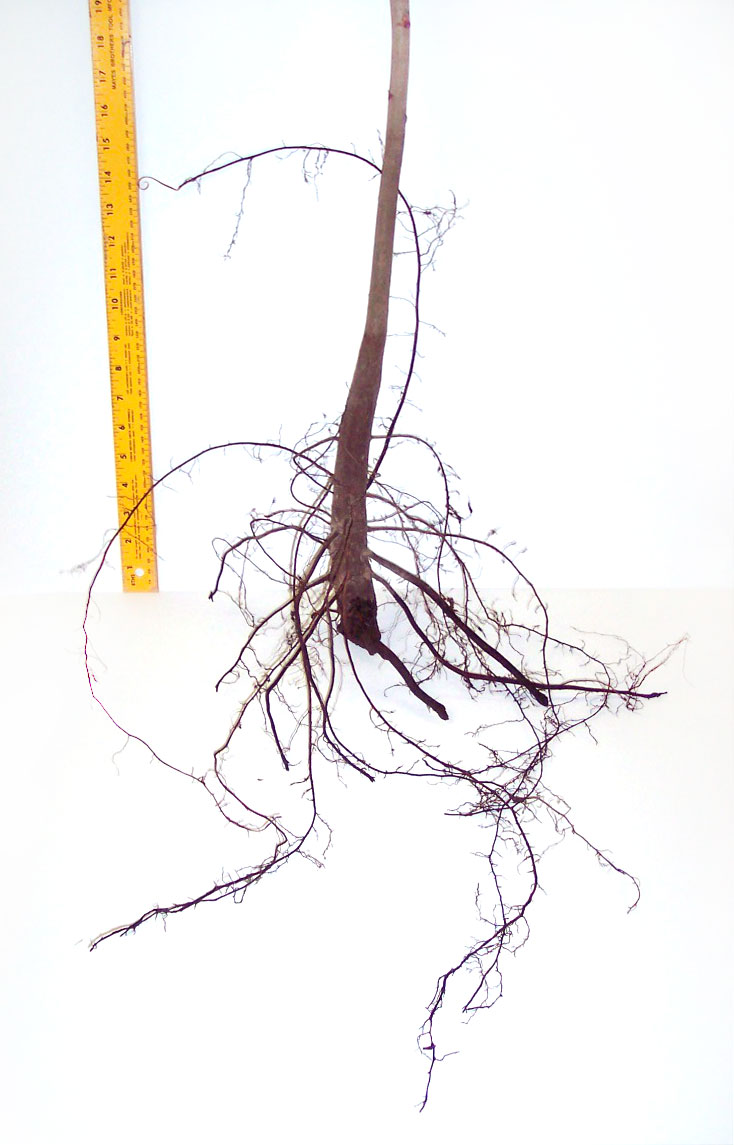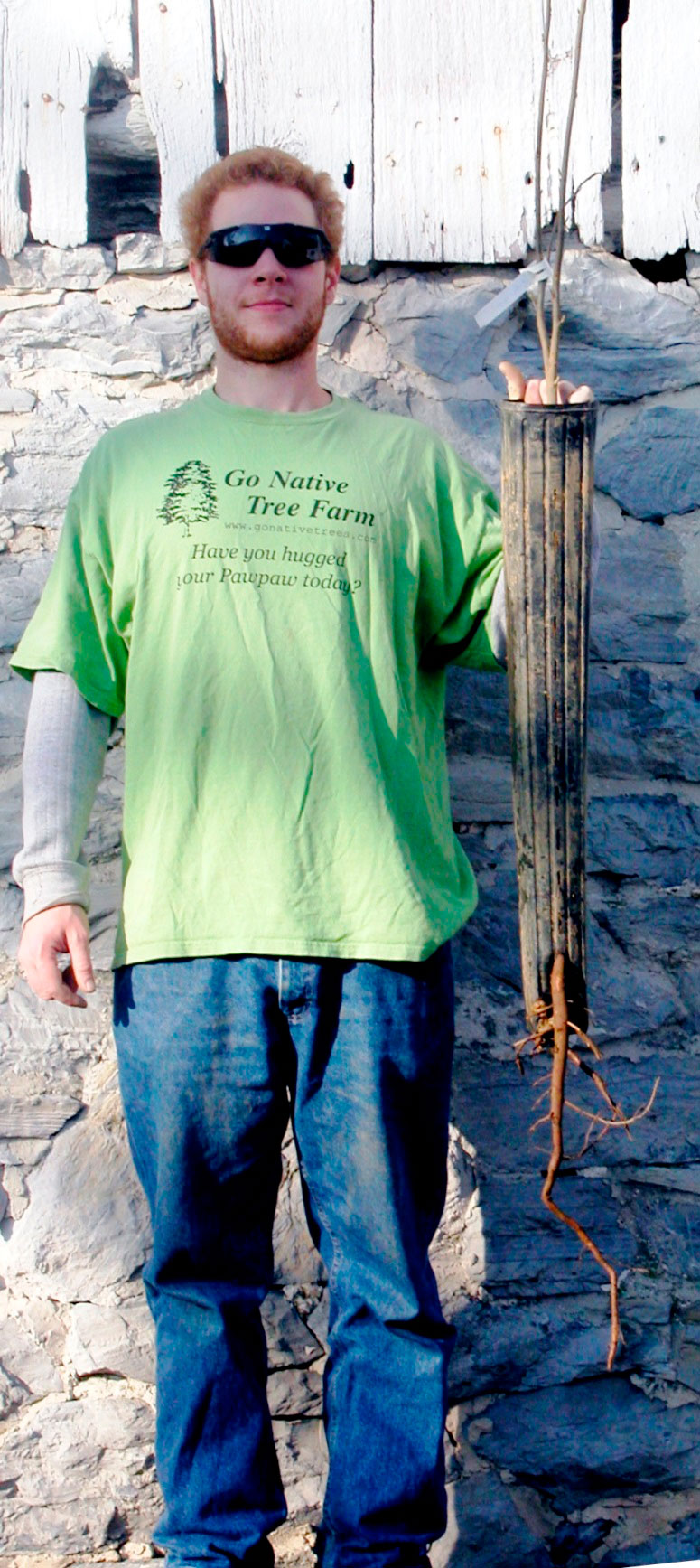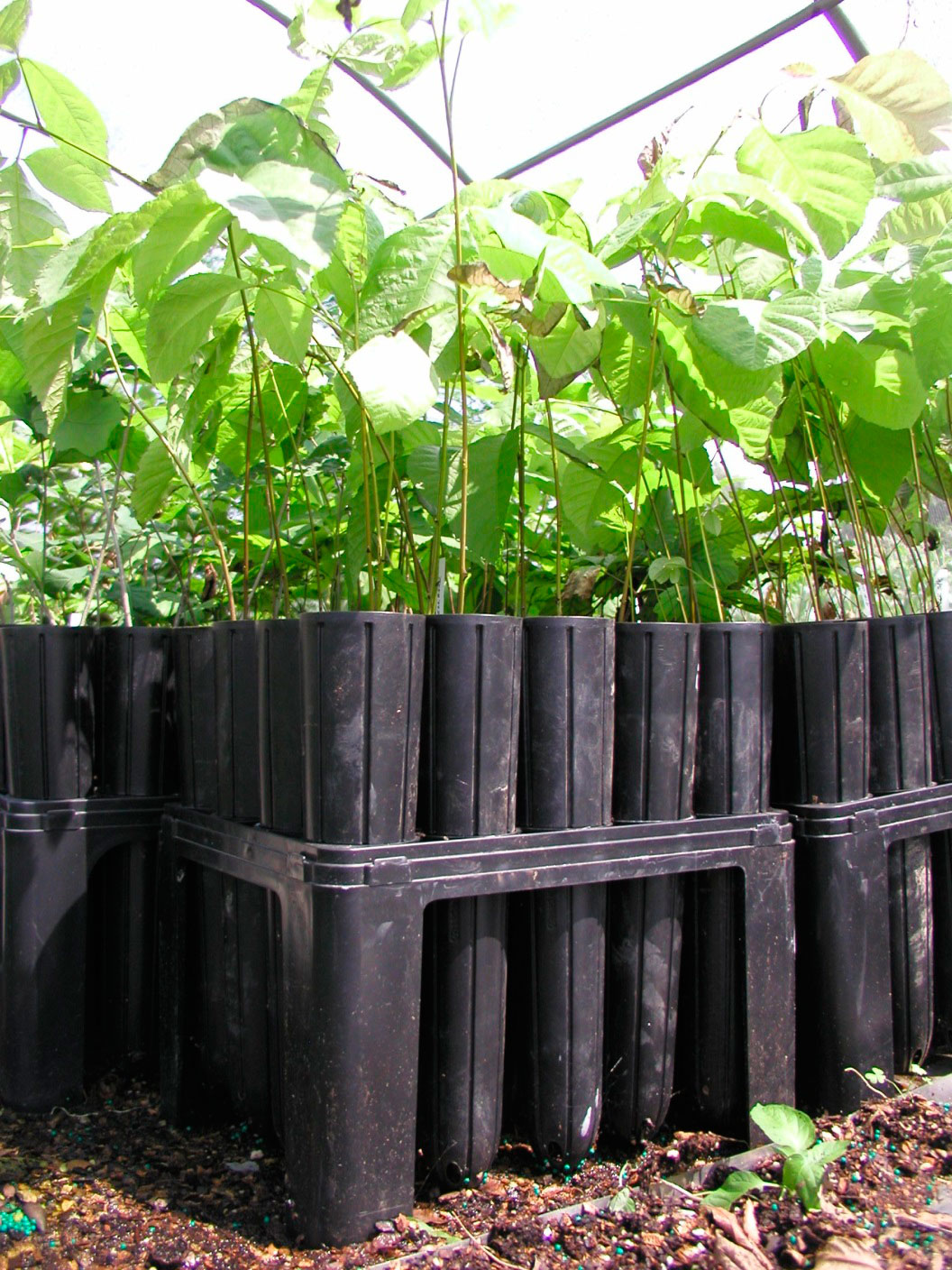Hickories: Why to Plant Them and How to Grow Them
Copyright 2013 by John H Rosenfeld and Hans C. Rosenfeld [GNTF co-founders]
Go Native Tree Farm is a volume grower of the six species of hickories (Carya sp.) native to PA and the northeast US. The list includes Shagbark Hickory (C. ovata), Shellbark Hickory (C.
laciniosa), Mockernut (C. tomentosa or C. alba), Bitternut (C. cordiformis), Pignut (C. glabra), and Red Hickory (C. ovalis). Here is a short essay on why you should include them in your
planting project and how we can help you to do it successfully.
Why Plant Hickories?
Most of the mid-Atlantic region of the eastern US is called oak-hickory forest because oaks and hickories constitute over half of the climax forest trees in our area. Even when the chestnut was a dominant forest tree, areas with alkaline limestone-based soils were home to hickory forests. Chestnuts and most oaks do not like limestone-based soils, so hickories predominated in these areas. The original name for Lancaster, PA was Hickorytown (before they cut them all down and changed the name).
Most native plant nurseries offer the oak species, but hickories have been hard to find in commerce, and have suffered from a lack of established growing techniques. How can you have an oak-hickory forest, if you don’t have any hickories? Nearly 200 species of butterflies and moths call hickories their food source, as well as countless animals that eat the nuts (including people). The wood is famously tough and resistant, and the fall yellow leaf colors are outstanding. With their large taproots, hickory trees will not lift up sidewalks or blow over easily in wind storms. This same taproot is also a wonderful solution to stream banks and hill restoration projects. When fully grown, they make a stately shade tree.
How to Plant Hickories
Hickories spend the first three to five years of their lives working to build a strong taproot, before growing even one foot in height above ground. This habit has confounded nurserymen until recently, and has given the genus a reputation as “difficult to transplant”. We have spent over ten years working on improved growing procedures for hickories, with a goal to solve this problem and introduce hickories into more widespread acceptance. First we describe the mistakes others have made in the past, to show why it is important to accommodate nature rather than attempt to fight it, if you want good results.
If hickory saplings are not handled well, they will not survive transplanting or die before they reach maturity. Here are examples of how not to grow hickories.
1) Bare Root Transplants. Because the hickory taproot is so vital, damaging it or chopping it to close to the ground surface will invariably damage or kill the plant. This is a common past mistake. The photo shows a sapling that was started in the ground, and then was extracted using a shallow tree spade. The taproot was chopped barely ten inches below the ground surface. Most of the taproot and feeder roots were lost during this process. Unfortunately, nearly all spades used for “balled & burlap” tree transplants also do not have the depth capability to avoid this problem. Attempts to transplant hickories in this manner will result in high mortality. Chopping a live plant into two pieces is a good example of a bad practice.

2) Use of Conventional Plant Containers. Because a hickory sapling grows a five to ten foot long taproot before reaching two feet in above-ground height, use of conventional shaped plant containers will eventually weaken and kill the plant. This happens because the taproot will invariably grow in circles around the base of the container, and it will literally tie itself in knots. As the plant grows, the taproot diameter increases until the plant strangles itself. Use of “Spinout” or similar container treatments does not seem to solve this problem. So, conventional containers do not work either.
3) Direct Seeding. Nature’s way of propagating hickory trees relies on squirrels and other animals to bury the nuts and forget about them. Unfortunately, hungry squirrels have a keen sense of smell, so they will dig up and eat nearly all of the nuts that you attempt to plant. Unless you have a dog that is willing to chase them off for the first year or two, direct seeding is not likely to solve the problem.
The Solution Is to Give Them What They Want

Long Pots Produce Hickory Saplings with Three Feet of Straight Taproot 
Shellbark Seedlings Grown in Tall Cells
We have had nearly 100% transplant by using taproot-shaped containers to grow taproot-producing plants. These containers are available now to commerce. Two container sizes have yielded best results. Tall cells are being used for seedlings, and larger tall containers are used to grow sapling up to 1” caliper.
We start our hickories in racks of deep cells. The opening at the cell base provides some air pruning assistance, so the plants can be grown happily for several years in this compact, low cost manner. Seedlings can be transplanted from these tapered cells using a tapered shovel. However, it is necessary to use protection for the seedlings for the first few years to protect them from rabbits, voles, deer, etc. Larger plants of greater than two feet height are often desired by customers.
To produce larger saplings, we have developed methods to grow hickories in larger taproot-shaped containers. After several years of experimenting with cut PVC pipe and other homemade approaches, we have happily adopted the 30” tall X 4” square tapered Long Pots. With these containers, a three foot length straight taproot can be accommodated. It is reasonable to grow a sapling to about 1” caliper in these pots. The photo shows a five year old shagbark that was grown in a Long Pot. We can now offer all six North Eastern US hickory species in larger sizes that are grown like this.
The first question people ask is about how to transplant such a tall plant. The answer depends on how many you need to plant. You will need to dig the hole the same shape as the container, i.e. 3” to 4” diameter X 30” deep. For just a few plants, a tapered shovel or a digging bar will suffice. For larger projects, a motorized auger or a tractor-mounted auger can make hundreds of holes in one day.
We welcome questions, comments, and customer feedback. Our goal is provide availability of well grown hickory plants for your planting project.
Availability for 2020
| Botanical Name | Common Name | Plant & Container Size | Number in Stock |
| Carya cordiformis | Bitternut Hickory | <18”, 2 gal.>18”, 2 gal.24-36”, 2 gal.6-12”, in 14” D60 | 680 450 520 200 |
| Carya glabra | Pignut Hickory | 12-24”, in tall 2 gal.8-24”, D60 cells | 5 480 |
| Carya illinoensis | (Hardy Northern) Pecan | 12-36”, in tall 2 gal. | 18 |
| Carya laciniosa | Shellbark Hickory | 12-24”, in tall 2 gal.6-12”, in D60 cells | 369 100 |
| Carya ovata | Shagbark Hickory | 12-24”, in tall 2 gal. 6-12”, 1 gal. 6-12”, in D60 cells | 579 44 1100 |
| Carya (alba) tomentosa | Mockernut Hickory | 10-18”, in tall 2 gal.12”, in D60 cells | 30400 |
Offer to License the Technology to Interested Parties
We are interested and willing to offer licensing of the procedures to grow hickories by this now-preferred method. We have worked at perfecting this approach for over 13 years, and involved considerable effort and expense. We can save you this trouble and enable you to begin production immediately. If your location is more than a few hours drive from Lancaster, PA, then our licensing fee will cost you less than the shipping cost difference from us to you. Moreover, we want to do what is the best interest of the forest species, and offer what will benefit the native plant grower community as well. Our offer includes the following:
- A detailed written procedure, including specifying critical materials, propagation steps, and pitfalls.
- Technical support as required.
- Agreement to first contact your nursery for material sought for larger projects, for which we need additional plants to fill orders.
- Sources of critical materials.
- Two-way non-disclosure agreement.
- Terms and conditions negotiable.
